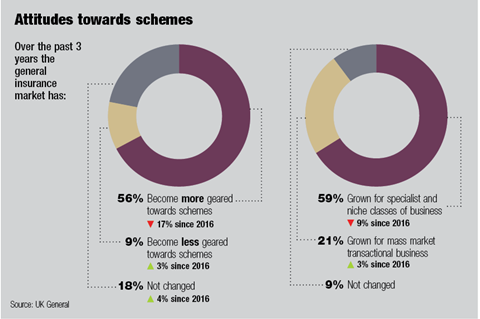Successful insurance schemes offer both underwriting profitability and low customer churn rates. So why is it so difficult for brokers to convince their insurer partners to get new ideas off the ground?
In a tough operating environment schemes business can offers brokers and insurers a profitable and loyal customer base. Churn rates for specialist schemes – personal lines and SME products tailored to a specific set of customers with a similar risk profile (eg tree surgeons, funeral directors, nannies, vintage car owners etc) – are significantly lower than for standard insurance products.
“Retention is at least 10% to 15% better on average because you’ve usually got a unique product,” says James Hallam chief executive officer Paul Anscombe. “You’ve got a different relationship as a broker because you understand that sector – so typically you’d expect retention rates to be 10% or more better than a retail book of business.”

“There are a lot of really good brokers where their schemes business is a relatively small part of their book and others where their entire business is based around one scheme,” he continues. “Generally schemes business performs well. And also when brokers come to sell their business, those that have got a proven scheme within their portfolio would certainly find it enhances the value of their business.”
Given these characteristics it is little surprise that this year’s survey by UK General suggests scheme brokers are optimistic about the sector’s growth prospects. Now in its fourth year the survey confirmed that schemes are a key source of revenue stream for brokers who operate in the sector. Nearly a third of respondents attribute two thirds of their GWP to schemes, with a further third accrediting one third of their GWP to schemes.

Nearly 40% of schemes brokers have seen up to 10% growth in schemes business during the past year, with 84% envisaging growth in their schemes portfolios over the next five years. “My message to those 30% brokers who are not active in schemes is: what on earth are you waiting for?” says UK General’s chief executive officer Karen Beales. “More than half of the brokers in our survey say niche and specialist business has grown in the last three years.”
Particular opportunities exist in emerging risk areas, such as cyber, and by making more of online distribution and marketing opportunities. Eighty-nine percent of respondents to the survey thought demand for cyber would grow in the next three years, with 64% of brokers believing it would work best as a household add-on
However, these burgeoning opportunities can also stifle innovation where there is a lack of historical claims data and therefore less of an ability to understand and price the exposure. “Innovation is harder when technology is consistently changing,” thinks Leah Church, schemes team manager, Covéa. “Emerging risks such as drones and cyber cover are being added to scheme products whilst the market is still relatively in the dark about the potential risks that this new technology could pose.”
“Another factor is that IT development is very expensive and can often be delivered very late, a prohibitive factor for schemes brokers, especially for small brokers or modest-sized schemes,” she adds.
The explosion of online buying has produced an opportunity for the insurance industry but at times it can be prohibitive, agrees Scott Brown, managing director of Accelerate Underwriting. “There are people out there with ideas, but the costs of doing that can be severe. Getting your scheme to come up on the first page of a Google search – pay-per-click – it costs a lot. So the online explosion is an opportunity for the insurance industry but it does lend itself to companies with a large marketing budget.”
“But if you’ve got the right marketing budget in place, and you’ve got a good platform and you can get to those customer groups and have got instant documentation that people can download and understand, then the online market is a very lucrative opportunity for the schemes insurance market,” he adds.

Getting schemes off the ground
Schemes are typically broker-led, given that brokers are close to their customers and in a position to spot and exploit an opportunity. However, it is not always easy to encourage general insurers to come on board, particularly for schemes that may start out extremely niche and are expected to take some time to gain momentum.
“Some of our insurance partners say yes to a new idea, but that they’ve got to be guaranteed a million pounds worth of business in the first year,” explains Barry Fehler, chief executive officer of SEIB Insurance Brokers. “So they’re setting the bar too high, rather than being willing to start something small and then growing it.”
“We’re looking to do a couple of things at the moment, but we can’t guarantee a minimum premium of a million pounds in the first year or two,” he continues. “Also a lot of them – particularly on the motor side – want to put customers through their own online system. This is very time consuming for us… we’re much better off with a binding authority.
“We probably will eventually get them all to market – but it is hard work,” he adds. “The smaller companies by and large are often better at taking on new scheme ideas – but not always. You’d think they’d be innovative and fleet of foot but that’s not always the case. In the good old days when we used to start a scheme up we had some good underwriters who would just go with it. Whereas now, there’s a lot of talk about new ways of marketing and repackaging existing schemes rather than producing new products.”
Partnering with an affinity body or trade organisation can be one way of reaching a broader customer base and encouraging insurance partners to come on board with a new scheme. Certainly in the days before e-marketing, the ability to market products endorsed by an affinity group was an important way of reaching a target market. However, in today’s industry such products are considered ‘old school’ by some, with a question mark over whether they are schemes in the true sense.
“Many years ago we came up with a scheme for motor caravans – and we found an underwriter willing to back it – but we couldn’t find a way of reaching the market,” says Fehler. “This was 30 to 40 years ago – pre-internet – and there wasn’t way of reaching the market at a reasonable cost. If you can find an affinity group or trade association to work with that often reduces a lot of the problems in bringing a new product to market.”

“We partner with the National Association of Funeral Directors,” he continues. “That gives us a lot of status. They recommend the scheme and we support them in other ways – attending trade shows and their annual conference, which really helps us to understand the issues they’ve got and the direction our customers’ businesses are going in. It does give us a lot of insight into the customers.”
For brokers struggling to find an insurance partner to support a new scheme idea, MGAs and reinsurers are stepping in to fill the void, according to Anscombe. With more realistic demands on first year GWP and an ability to offer what the brokers really want – including bespoke products and delegated authority – the sector has shown itself to be ripe for disruption.
“The bulk of the UK general commercial spend is on standard major insurer contracts and insurers almost have a vested interest to using their systems procedures and wordings and that’s a real barrier to creating a new scheme,” says Anscombe. “Minimum requirements could be £250,000 or half a million pound of income, which for a broker developing a new scheme can be really hard to guarantee.”

“More-and-more reinsurers and MGAs are stepping more into the relationship with brokers and they can be often far more flexible than the traditional GI insurer and therefore give the broker a competitive edge on a scheme,” he continues. “Reinsurers are often happier to let the broker take a greater lead in the product development and give them more flexibility.”
“Whereas if you go to a major GI, the starting point is their standard commercial package policy and you’re trying to adapt that into a scheme wording,” he adds. “Whereas with an MGA or a reinsurer you can start afresh and create something that’s truly unique rather than an adopted version.”
Big voices: Is innovation still alive within the schemes market?
Leah Church, schemes team manager, Covéa Insurance
The schemes space is full of innovation and new ideas. Schemes often focus on niche and specialist areas clearly differentiated from the open market and can therefore encompass some unusual areas. The diversity of schemes means the market has to constantly change in order to stay on top of new specialist areas, modernise existing specialisms and provide new types of cover. So by its very nature it is a bedrock of creativity.
Katie Balme, head of schemes & deals development, Commercial Risk Solutions, RSA
There is an upturn in innovation among brokers as well as insurers that are developing schemes by consolidating groups of customers, servicing new trends or partnering with affinities. As well as innovation through the creativity of the ideas, we are also seeing brokers source their own third-party software solutions to deploy our agreed delegation to customers online. This is mixed across both regional and national brokers. I can see new schemes becoming more prevalent as it becomes harder to gain a competitive edge by traditional means (e.g. price, technology) and as offerings become more targeted at customer sectors or interests.
Scott Brown, managing director, Accelerate Underwriting
As an industry we’ve got far better at targeting customer groups than we used to be. There are segments of customers who are after the same thing and brokers and underwriters are getting far better at producing products that are meeting customers’ needs. But there’s still a long way to go. We still see a lot of schemes from brokers that are very expense heavy and that are done on a manual basis.







































No comments yet